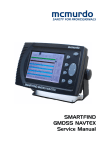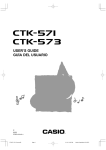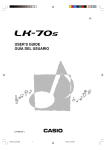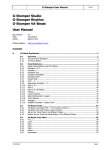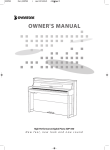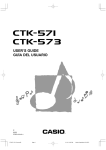Download Casio LK-73 Specifications
Transcript
MIDI MIDI 1 4 7 MODE START/STOP 2 5 TRANSPOSE/TUNE/MIDI 3 6 LEFT/TRACK 1 Number buttons RIGHT/TRACK 2 [+]/[–] What is MIDI? The letters MIDI stand for Musical Instrument Digital Interface, which is the name of a worldwide standard for digital signals and connectors that makes it possible to exchange musical data between musical instruments and computers (machines) produced by different manufacturers. MIDI compatible equipment can exchange keyboard key press, key release, tone change, and other data as messages. Though you do not need any special knowledge about MIDI to use this keyboard as a stand-alone unit, MIDI operations require a bit of specialized knowledge. This section provides you with an overview of MIDI that will help to get you going. MIDI Connections MIDI messages are send out through the MIDI OUT terminal of one machine to the MIDI IN terminal of another machine over a MIDI cable. To send a message from this keyboard to another machine, for example, you must use a MIDI cable to connect the MIDI OUT terminal of this keyboard to the MIDI IN terminal of the other machine. To send MIDI messages back to this keyboard, you need to use a MIDI cable to connect the other machine’s MIDI OUT terminal to the MIDI IN terminal of this keyboard. To use a computer or other MIDI device to record and playback the MIDI data produced by this keyboard, you must connect the MIDI IN and MIDI OUT terminals of both machines in order to send and receive data. 641A-E-053A 1 Computer or other MIDI device To use the MIDI THRU function of a connected computer, sequencer, or other MIDI device, be sure to turn this keyboard’s LOCAL CONTROL off (page E-54). MIDI Channels MIDI allows you to send the data for multiple parts at the same time, with each part being sent over a separate MIDI channel. There are 16 MIDI channels, numbered 1 through 16, and MIDI channel data is always included whenever you exchange data (key press, pedal operation, etc.). Both the sending machine and the receiving machine must be set to the same channel for the receiving unit to correctly receive and play data. If the receiving machine is set to Channel 2, for example, it receives only MIDI Channel 2 data, and all other channels are ignored. E-51 MIDI Changing MIDI Settings You can use this keyboard in combination with an external sequencer, synthesizer, or other MIDI device to play along with commercially available General MIDI software. This section tells you how to make the MIDI settings required when connecting to an external device. TRANSPOSE/TUNE/MIDI Button This keyboard is equipped with multi-timbre capabilities, which means it can receive messages over all 16 MIDI channels and play up to 16 parts at the same time. Keyboard and pedal operations performed on this keyboard are sent out by selecting a MIDI channel (1 to 16) and then sending the appropriate message. General MIDI As we have already seen, MIDI makes is possible to exchange musical data between devices produced by different manufacturers. This musical data does not consist of the notes themselves, but rather information on whether a keyboard key is pressed or released, and the tone number. If tone number 1 on a keyboard produced by Company A is PIANO while tone number 1 on a Company B’s keyboard is BASS, for example, sending data from Company A’s keyboard to Company B’s keyboard produces a result entirely different from the original. If a computer, sequencer or other device with auto accompaniment capabilities is used to produce music data for the Company A keyboard which has 16 parts (16 channels) and then that data is sent to the Company B keyboard which can receive only 10 parts (10 channels), the parts that cannot be played will not be heard. The standard for the tone numbering sequence, the number of pads, and other general factors that determine the sound source configuration, which was arrived at by mutual consultations by manufacturers, is called General MIDI. The General MIDI standard defines the tone numbering sequence, the drum sound numbering sequence, the number of MIDI channels that can be used, and other general factors that determine the sound source configuration. Because of this, musical data produced on a General MIDI sound source can be played back using similar tones and identical nuances as the original, even when played on another manufacturers sound source. This keyboard conforms with General MIDI standards, so it can be connected to a computer or other device and used to play back General MIDI data that has been purchased, downloaded from the Internet, or obtained from any other source. E-52 Each press of the TRANSPOSE/TUNE/MIDI button cycles through a total of 12 setting screens: the transpose screen, the tuning screen, and 10 MIDI setting screens. If you accidentally pass the screen you want to use, keep pressing the TRANSPOSE/TUNE/MIDI button until the screen appears again. Also note that leaving a setting screen is automatically cleared from the display if you do not perform any operation for about five seconds. GM MODE (Default: Off) J on This keyboard plays General MIDI data from a computer or other external device. MIDI IN CHORD JUDGE cannot be used when GM MODE is turned on. J oFF MIDI IN CHORD JUDGE can be used. 1. Press the TRANSPOSE/TUNE/MIDI button until the GM MODE screen appears. Example: When GM MODE is turned off 641A-E-054A MIDI 2. Use the [+] and [–] or [0] and [1] buttons to turn the setting on and off. 1. Example: Press the TRANSPOSE/TUNE/MIDI button until the NAVIGATE CHANNEL screen appears. To turn GM MODE on 2. Use the [+], [–], and the number buttons [1] through [8] to change the channel number. Example: To specify channel 2 1 Lit KEYBOARD CHANNEL The keyboard channel is the channel used to send MIDI messages from this keyboard to an external device. You can specify one channel from 1 to 16 as the keyboard channel. 1. Press the TRANSPOSE/TUNE/MIDI button until the KEYBOARD CHANNEL screen appears. The navigate channel automatically changes to 1 whenever you turn MIDI IN CHORD JUDGE. J To turn off specific sounds before playing back MIDI data that is being received Navigate channel on/off 2. 1. Use the [+], [–], and the number buttons to change the channel number. While playing MIDI data, press the RIGHT/ TRACK 2 button. This cuts the sound of the navigate channel, but keyboard keys continue to light in accordance with the channel’s data as it is received. Press the RIGHT/TRACK 2 button again to turn the channel back on. Example: To specify channel 4 Next lower channel from navigate channel on/off 1. NAVIGATE CHANNEL (Default: 4) When MIDI messages are received from an external device for play on this keyboard, the navigate channel is the channel whose note data appears on the display and is used to light keyboard keys. You can select one channel from 1 to 8 as the navigate channel. Since this setting lets you use the data on any channel of commercially available MIDI software to light the keyboard keys, you can analyze how different parts of an arrangement are played. 641A-E-055A While playing MIDI data, press the LEFT/ TRACK 1 button. This cuts the sound of the channel whose number is one less than the navigate channel, but keyboard keys continue to light in accordance with the channel’s data as it is received. Press the LEFT/TRACK 1 button again to turn the channel back on. Example: If the navigate channel is channel 4, the above operation turns off channel 3. If the navigate channel is channel 1 or 2, the above operation turns off channel 8. E-53 MIDI MIDI IN CHORD JUDGE (Default: Off) the no sound is produced by the keyboard if LOCAL CONTROL is turned off and no external device is connected. 1. J on When a chord specification method is selected by the MODE switch, chords are specified by the keyboard channel note data input from the MIDI IN terminal. Press the TRANSPOSE/TUNE/MIDI button until the LOCAL CONTROL screen appears. Example: When LOCAL CONTROL is on J oFF MIDI IN CHORD JUDGE is turned off. 1. Press the TRANSPOSE/TUNE/MIDI button until the MIDI IN CHORD JUDGE screen appears. 2. Use the [+] and [–] or [0] and [1] buttons to turn the setting on and off. Example: To turn LOCAL CONTROL off 2. Use the [+] and [–] or [0] and [1] buttons to turn the setting on and off. Example: To turn MIDI IN CHORD JUDGE on MIDI IN CHORD JUDGE automatically turns off whenever you change the navigate channel to any channel besides 01. LOCAL CONTROL (Default: On) This setting determines whether or not the keyboard and sound source of this keyboard are connected internally. When recording to a computer or other external device connected to this keyboard’s MIDI IN/OUT terminal, it helps if you turn LOCAL CONTROL off. J on LOCAL CONTROL On Notes played on the keyboard are sounded by the internal sound source and output as MIDI messages from the MIDI OUT terminal. LOCAL CONTROL Off Notes played on the keyboard are output as MIDI messages from the MIDI OUT terminal, but not sounded directly by the internal sound source. The MIDI THRU terminal of the connected device can be used to return the MIDI message and sound it on this keyboard’s sound source. Anything played on the keyboard is sounded by the internal sound source and simultaneously output as a MIDI message from the MIDI OUT terminal. J oFF Anything played on the keyboard is output as a MIDI message from the MIDI OUT terminal, without being sounded by the internal sound source. Turn LOCAL CONTROL off whenever you are using the MIDI THRU function of a computer or other external device. Also note that E-54 641A-E-056A MIDI ACCOMP MIDI OUT (Default: Off) 2. Use the [+] and [–] or [0] and [1] buttons to change the setting. Example: J on To select touch curve 1 Auto Accompaniment is played by the keyboard and the corresponding MIDI message is output from the MIDI OUT terminal. J oFF Auto Accompaniment MIDI messages are not output from the MIDI OUT terminal. 1. Press the TRANSPOSE/TUNE/MIDI button until the ACCOMP MIDI OUT screen appears. Example: When ACCOMP MIDI OUT is off SUSTAIN/ASSIGNABLE JACK J SUS (sustain) Specifies a sustain*1 effect when the pedal is depressed. J SoS (sostenuto) Specifies a sostenuto*2 effect when the pedal is depressed. 2. J SFt (soft) Use the [+] and [–] or [0] and [1] buttons to turn the setting on and off. Specifies reduction of the sound’s volume when the pedal is depressed. Example: To turn ACCOMP MIDI OUT on J rHy (rhythm) Specifies the START/STOP button operation when the pedal is depressed. 1. TOUCH CURVE (Default: 0) Press the TRANSPOSE/TUNE/MIDI button until the SUSTAIN/ASSIGNABLE JACK screen appears. Example: When sustain is currently set J 0 Normal touch curve J 1 Louder than normal tone, even when little pressure is used to press keyboard keys. When touch response is turned off, sound is produced at a louder volume than normal. 1. 2. Use the [+] and [–] or [0], [1], [2], and [3] buttons to change the setting. Example: To select rhythm Press the TRANSPOSE/TUNE/MIDI button until the TOUCH CURVE SELECT screen appears. *1. Sustain With piano tones and other sounds that decay, the pedal acts as a damper pedal, with sounds being sustained longer when the pedal is depressed. With organ tones and other continuous sounds, notes played on the keyboard continue to sound until the pedal is released. In either case, the sustain effect is also applied to any notes that are played while the pedal is depressed. 641A-E-057A E-55 MIDI *2. Sostenuto This effect performs the same way as sustain, except that it is applied only to notes that are sounding already when the pedal is depressed. It does not affect notes that are played after the pedal is depressed. Messages There is a wide variety of messages defined under the MIDI standard, and this section details the particular messages that can be sent and received by this keyboard. An asterisk is used to mark messages that affect the entire keyboard. Messages without an asterisk are those that affect only a particular channel. NOTE ON/OFF SOUND RANGE SHIFT (Default: On) This message sends data when a key is pressed (NOTE ON) or released (NOTE OFF). A NOTE ON/OFF message include a note number (to indicate note whose key is being pressed or released) and velocity (keyboard pressure as a value from 1 to 127). NOTE ON velocity is always used to determine the relative volume of the note. This keyboard does not receive NOTE OFF velocity data. Whenever you press or release a key on this keyboard, the corresponding NOTE ON or NOTE OFF message is sent from the MIDI OUT terminal. J on Shifts low range tones one octave lower and “072 PICCOLO” one octave higher. J oFF Plays low range tones and “072 PICCOLO” at their normal levels. 1. 2. Press the TRANSPOSE/TUNE/MIDI button until the SOUND RANGE SHIFT screen appears. Use the [+] and [–] or [0] and [1] buttons to change the setting. The pitch of a note depends on the tone that is being used, as shown in the “Note Table” on page A-1. Whenever this keyboard receives a note number that is outside its range for that tone, the same tone in the nearest available octave is substituted. Example: To turn SOUND RANGE SHIFT off E-56 641A-E-058A MIDI PROGRAM CHANGE This is the tone selection message. PROGRAM CHANGE can contain tone data within the range of 0 to 127. A PROGRAM CHANGE message is sent out through this keyboard’s MIDI OUT terminal whenever you manually change its tone number. Receipt of a PROGRAM CHANGE message from an external machine changes the tone setting of this keyboard. This keyboard supports 128 tones in the range 0 to 127. However, Channel 10 is a percussion-only channel, and Channels 0, 8, 16, 24, 25, 32, 40, 48, and 62 correspond to the nine drum set sounds of this keyboard. * RPN stands for Registered Parameter Number, which is a special control change number used when combining multiple control changes. The parameter being controlled is selected using the control values of control numbers 100 and 101, and then settings are made using the control values of DATA ENTRY (control numbers 6 and 38). This keyboard uses RPN to control this keyboard’s pitch bend sense (pitch change width in accordance with bend data) from another external MIDI device, transpose (this keyboard’s overall tuning adjusted in halftone units), and tune (this keyboard’s overall fine tuning). Sustain (control number 64), sostenuto (control number 66), and soft (control number 67) effects applied using the foot pedal are also applied. ALL SOUND OFF PITCH BEND This message carries pitch bend information for smoothly sliding the pitch upwards or downwards during keyboard play. This keyboard does not send pitch bend data, but it can receive such data. This message forces all sound being produced over the current channel to turn off, regardless of how the sound is being produced. ALL NOTES OFF CONTROL CHANGE This message adds effects such as vibrato and volume changes applied during keyboard play. CONTROL CHANGE data includes a control number (to identify the effect type) and a control value (to specify the on/off status and depth of the effect). The following is a list of data that can be sent or received using CONTROL CHANGE. Effect Control Number Modulation 1 Volume 7 Pan 10 Expression 11 Hold 1 64 Sostenuto 66 Soft Pedal 67 RPN* Data Entry 100 / 101 This message turns off all note data sent from an external device and currently being sounded on the channel. Any notes being sustained using a sustain pedal or sostenuto pedal continue to sound until the next pedal off. RESET ALL CONTROLLERS This messages initializes pitch bend and all other control changes. SYSTEM EXCLUSIVE* This message is used to control system exclusives, which are tone fine adjustments that are unique to a particular machine. Originally, system exclusives were unique to a particular model, but now there are also universal system exclusives that are applicable to machines that are different models and even produced by different manufacturers. The following are the system exclusive messages supported by this keyboard. 6/38 indicates receive-only messages 641A-E-059A E-57 MIDI J GM SYSTEM ON ([F0][7E][7F][09][01][F7]) GM SYSTEM ON is used by an external machine to turn on this keyboard’s GM system. GM stands for General MIDI. GM SYSTEM ON takes more time to process than other messages, so when GM SYSTEM ON is stored in the sequencer it can take more than 100msec until the next message. J GM SYSTEM OFF ([F0][7E][7F][09][02][F7]) GM SYSTEM OFF is used by an external machine to turn off this keyboard’s GM system. E-58 641A-E-060A Troubleshooting Troubleshooting Problem No keyboard Sound Possible Cause Action See Page 1. Power supply problem. 1. Correctly attach the AC adaptor, make sure that batteries (+/–) are facing correctly, and check to make sure that batteries are not dead. Pages E-13, E-14 2. Power is not turned on. 2. Press the POWER button to turn on power. Page E-18 3. Volume setting is too low. 3. Use the VOLUME slider to increase volume. Page E-18 4. The MODE switch is in the CASIO 4. Normal play is not possible on the Page E-22 accompaniment keyboard while CHORD or FINGERED position. the MODE switch is set to CASIO CHORD or FINGERED. Change the MODE switch setting to NORMAL. Any of the following symptoms while using battery power. 5. LOCAL CONTROL is off. 5. Turn on LOCAL CONTROL. Page E-54 6. MIDI data has changed the VOLUME and EXPRESSION settings to 0. 6. Adjust both parameters. Page E-57 Low battery power Replace the batteries with a set of new ones or use the AC adaptor. Pages E-13, E-14 Dim power indicator Instrument does not turn on Display that is flickering, dim, or difficult to read Abnormally low speaker/ headphone volume Distortion of sound output Occasional interruption of sound when playing at high volume Sudden power failure when playing at high volume Flickering or dimming of the display when playing at high volume Continued sound output even after you release a key A tone that is totally different from the one that is selected Abnormal rhythm pattern and Song Bank play Dimming of keyboard lights when notes sound Loss of power, sound distortion, or low volume when playing from a connected computer or MIDI device Auto Accompaniment does not sound. Accompaniment volume is set to 000. Use the ACCOMP VOLUME button to increase the volume. Sound output does not change when Touch response is turned off. key pressure is varied. 641A-E-061A Press the TOUCH RESPONSE button to turn it on. Page E-27 Page E-49 E-59 Troubleshooting Problem Key light stays on. Possible Cause Keyboard is waiting for play of the correct note during Step 1 or Step 2 play. Action See Page 1. Press the lit key to continue with Step 1 or Step 2 play. Pages E-33, E-34 2. Press the START/STOP button to quit Step 1 or Step 2 play. Pages E-33, E-34 Keys are lit though no sound is being Power on alert is reminding you that Press any button or keyboard key to produced. power was left on without any restore power to normal. operation being performed. Page E-14 When playing with another MIDI instrument, keys or tunings do not match. Transpose or tuning is set to a value other than 00. Use the TRANSPOSE/TUNE/MIDI button to display the applicable setting screens and set both transpose and tuning to 00. Pages E-49, E-50 Cannot record Auto Accompaniment or rhythm. Track other than Track 1 is selected as the recording track. Use the track select buttons to select Track 1. (Track 2 is melody track.) Page E-37 When playing General MIDI data with a computer, playback notes do not match those produced when lit keys are pressed. Wrong SOUND RANGE SHIFT setting Use the TRANSPOSE/TUNE/MIDI button to display the SOUND RANGE SHIFT screen and correct the setting. Page E-56 Playing on the keyboard produces an The computer’s MIDI THRU unnatural sound when connected to function is turned on. a computer. Turn off the MIDI THRU function on Page E-54 the computer or turn off LOCAL CONTROL on the keyboard. Cannot record chord ACCOMP MIDI OUT is turned off. accompaniment data on a computer. Turn on ACCOMP MIDI OUT. E-60 Page E-55 641A-E-062A Specifications Specifications Model: LK-73 Keyboard: 73 standard-size keys, 6 octaves (with touch response on/off) Key Light System: Can be turned on and off (up to 10 keys can be lit at the same time) Tones: 137 (128 General MIDI tones + 9 drum tones); with layer and split Rhythm Instrument Tones: 61 Polyphony: 24 notes maximum (12 for certain tones) Auto Accompaniment Rhythm Patterns: 100 Tempo: Variable (216 steps, = 40 to 255) Chords: 3 fingering methods (CASIO CHORD, FINGERED, FULL RANGE CHORD) Rhythm Controllers: START/STOP, INTRO, NORMAL/FILL-IN, VAR/FILL-IN, SYNCHRO/ENDING Accomp Volume: 0 to 127 (128 steps) 3-step Lesson: Playback: 3 lessons (Step 1, 2, 3) Repeat play of a single tune Song Bank Number of Tunes: 100 Controllers: PLAY/PAUSE, STOP, FF, REW, LEFT/TRACK 1, RIGHT/TRACK 2 Musical Information Function: Tone, Auto Accompaniment, Song Bank numbers and names; staff notation, tempo, metronome, measure and beat number, step lesson display, chord name, dynamic mark, fingering, octave mark, pedal operation Metronome: On/Off Beat Specification: 1 to 6 Song Memory Songs: 2 Recording Tracks: 2 Recording Methods: Real-time, step Memory Capacity: Approximately 5,200 notes (total for two songs) MIDI: 16 multi-timbre receive, GM Level 1 standard Other Functions Transpose: 25 steps (–12 semitones to +12 semitones) Tuning: 101 steps (A4 = approximatery 440Hz ±50Cents) Terminals MIDI Terminals: IN, OUT Sustain/Assignable Terminal: Standard jack (sustain, sostenuto, soft, rhythm start/stop) Headphone/Output Terminal: Stereo standard jack Output Impedance: 100 Output Voltage: 4V (RMS) MAX Power Jack: 641A-E-063A 9V DC E-61 Specifications Power Supply: 2-way Batteries: 6 D-size batteries Battery Life: Approximately 5 hours continuous operation on manganese batteries AC Adaptor: AD-5 Auto Power Off: Turns power off approximately 6 minutes after last key operation. Enabled under battery power only, can be disabled manually. Speaker Output: 3W + 3W Power Consumption: 9V Dimensions: 116.2 × 42.1 × 14.2 cm (45 13/16 × 16 9/16 × 5 5/8 inch) Weight: Approximately 8.7 kg (19.2 lbs)(without batteries) 7.7W Design and specifications are subject to change without notice. E-62 641A-E-064A Care of your keyboard Care of your keyboard J Avoid heat, humidity or direct sunlight. Do not overexpose the instrument to direct sunlight, or place it near an air conditioner, or in any extremely hot place. J Do not use near a TV or radio. This instrument can cause video or audio interference with TV and radio reception. If this happens, move the instrument away from the TV or radio. J Do not use lacquer, thinner or similar chemicals for cleaning. Clean the keyboard with a soft cloth dampened in a weak solution of water and a neutral detergent. Soak the cloth in the solution and squeeze until it is almost dry. J Avoid use in areas subjected to temperature extremes. Extreme heat can cause figures on the LCD screen to become dim and difficult to read. This condition should correct itself when the keyboard is brought back to normal temperature. You may notice lines in the finish of the case of this keyboard. These lines are a result of the molding process used to shape the plastic of the case. They are not cracks or breaks in the plastic, and are no cause for concern. 641A-E-065A E-63 641A-E-130A Appendix/Apéndice Appendix/Apéndice Note Table 1. 2. 3. 4. Tone number Maximum polyphony Range type Recommended sound range for General MIDI The meaning of each range type is described to the right. The pitch of tones marked with an asterisk does not change, no matter which keyboard key is pressed. Percussion sounds (tone numbers 128 to 136) have maximum polyphony of 12. Turning on SOUND RANGE SHIFT (page E-56) causes range type B Tone (072 PICCOLO) to shift by one octave. 641A-E-131A Tabla de notas 1. 2. 3. 4. Número de sonido Polifonía máxima Tipo de gama Gama de sonido recomendado por la MIDI General El significado de cada tipo de gama se describe a la derecha. La altura tonal de los sonidos marcados con un asterisco no cambian, sin tener en cuenta qué tecla del teclado se presiona. Los sonidos de percusión (números de sonido 128 a 136) tienen una polifonía máxima de 12. Activando SOUND RANGE SHIFT (página S-56) ocasiona que el sonido (072 PICCOLO) de tipo de gama B se desplace en una octava. A-1 Appendix/Apéndice A-2 641A-E-132A Appendix/Apéndice Drum Assignment List (“” Indicates the same sound as STANDARD SET) 641A-E-133A A-3 Appendix/Apéndice Fingered Chord Chart A-4 Cuadro de acordes Fingered 641A-E-134A Appendix/Apéndice 641A-E-135A A-5 Appendix/Apéndice Rhythm List A-6 Lista de ritmos 641A-E-136A 641A-E-137A 641A-E-138A 641A-E-139A


























